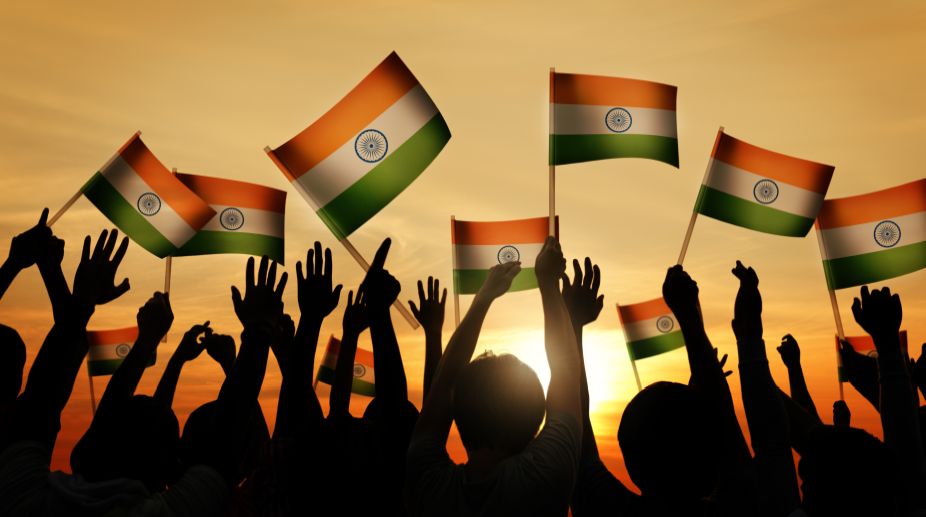‘Chhatrapati Shivaji Maharaj Katha’ at Patanjali University concludes
The narration of ‘Chhatrapati Shivaji Maharaj Katha’ being organised at Patanjali University on the ocassion of Chaitra Navratri, Ram Navami,…

(Photo: Getty Images)
The Karnataka government recently constituted a committee to explore the possibilities of formally adopting a state flag in addition to the national flag.
The genie is out and it may be difficult to put it back in the bottle. If the committee finds that legally it is not permissible to adopt a formal flag by the state government, then there will be demands for constitutional amendments.
The issue of separate flags for state governments has generated intense debate about the formal symbols of state power.
Advertisement
The opponents of the move argue that the ruling party is looking for an emotive issue to overcome anti-incumbency, as the elections for the state assembly are round the corner. On the other hand, the supporters argue that in other federal/ democratic countries such as the United States, states have separate flags as a celebration of local identities. Therefore, similar symbolic measures can also be adopted in India.
The call for the celebration of local identities need not be framed as a ‘secessionist’ tendency. Similarly, concerns about Indian states having a separate flag need not be tossed aside as a manifestation of a cultural homogenisation tendency.
After all, India has witnessed and continues to experience armed insurgencies in different parts of the country.
So, proponents on both sides of the argument should view each other with empathy and refrain from questioning each other’s commitment to ideals such as patriotism or a desire to find common ground through deliberation.
The discussion on a separate flag for the state governments once again brought into relief the growing salience of identity politics and the demands for further strengthening the federal impulse, not merely in the financial domain but also in the realm of symbols. The rise of identity politics and associated anxieties are also a consequence of growing interconnectedness in our society.
With the growth of social media, people with different linguistic, religious and cultural identities are interacting with each other with greater intensity on the virtual domain.
A Facebook post by an individual, tweets by a small group of people within or even from outside the country, and conversations between friends on social media today have a pan-India impact.
The photograph, which shows a few individuals blackening Hindi words on a signage, is being seen by millions on their mobile phones. What would have been a small news item in a local newspaper a few years ago now amounts to an in-your-face act, which triggers a nation-wide conversation on the language policy.
In the face of such rapid spread of information, sometimes rumours, there is a renewed attempt to symbolically assert different identities. It is being argued that the current demand for a state flag is a response against homogenising tendencies such as the alleged imposition of Hindi by the central government. However, the concepts of ‘homogenisation’ and ‘celebration of difference’ needs careful evaluation.
Just as India is an incredibly diverse country, various states in India host considerable linguistic, religious and cultural diversity. Take Karnataka for instance; it consists of Uttar Karnataka, Dakshin Karnataka and the coastal regions to name a few.
Even within these regions, there is considerable diversity with places such as Coorg having distinct traditions. Andhra Pradesh has three regions – North Coastal, Central and Rayalaseema – which are similar and also distinct. The Uttar Pradesh assembly in 2011 has passed a resolution for division of the state into four different states. West Bengal is currently experiencing agitation for a separate state of Gorkhaland. In the light of such tremendous diversity within states, the demand for a ‘single flag’ to represent a state is not recognition of diversity, but rather is a celebration of ‘singular identity’ based language.
The linguistic sub-nationalism, like all other nationalisms, also seeks to homogenise rather than celebrate diversity. The debates on Indian federalism, which often focus on centre-state relations, should now reflect on effective ways to respond to the calls for celebration and inclusion of diversities within the states in the governance process. It is not mandatory that such steps should always result in the formation of new states.
The local self-governments, which now have constitutional sanctity after the 73rd and the 74th Amendment, should be strengthened with a substantive devolution of funds, functions and functionaries. This is necessary, as common people often interact with the local authorities more often and with greater intensity than with the central government.
The local governments, which are the third-tier of Indian federalism should be strengthened by ushering in District Government with a directly elected chief and a small pool of ministers answerable to the Zilla Parishad.
Such devolution of power will break the hold of a few dominant caste/ethnic groups on the governance process in the states. After such decentralisation, if the state governments are to have separate flags, then even the Zilla Parishads may be allowed to have separate flags.
Since we have a penchant for citing the US experience, let it be noted that various counties/municipalities in the USA also have separate flags. It is time to fly the flag of decentralisation in India as well.
(The writer works as a Senior Consultant at the ICRIER, New Delhi. The views expressed are personal.)
Advertisement